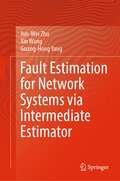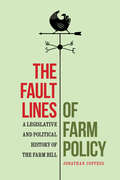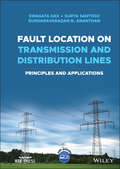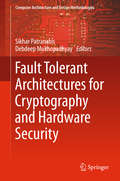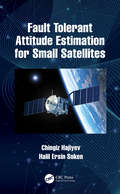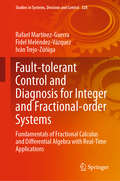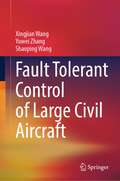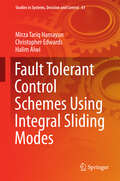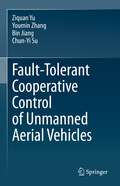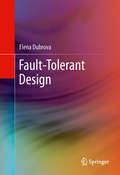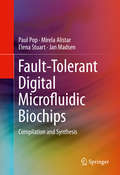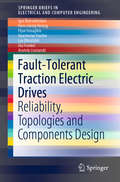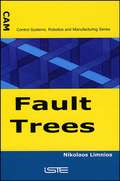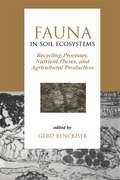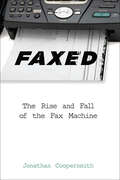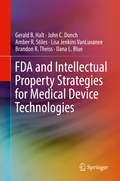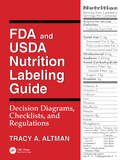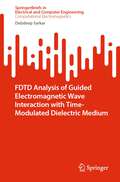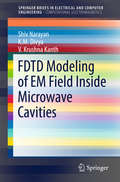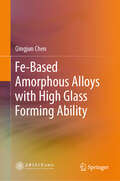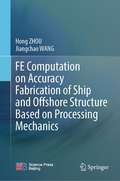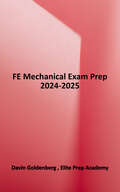- Table View
- List View
Fault Diagnosis, Prognosis, and Reliability for Electrical Machines and Drives (IEEE Press)
by Elias G. Strangas Guy Clerc Hubert Razik Abdenour SoualhiFault Diagnosis, Prognosis, and Reliability for Electrical Machines and Drives An insightful treatment of present and emerging technologies in fault diagnosis and failure prognosis In Fault Diagnosis, Prognosis, and Reliability for Electrical Machines and Drives, a team of distinguished researchers delivers a comprehensive exploration of current and emerging approaches to fault diagnosis and failure prognosis of electrical machines and drives. The authors begin with foundational background, describing the physics of failure, the motor and drive designs and components that affect failure and signals, signal processing, and analysis. The book then moves on to describe the features of these signals and the methods commonly used to extract these features to diagnose the health of a motor or drive, as well as the methods used to identify the state of health and differentiate between possible faults or their severity. Fault Diagnosis, Prognosis, and Reliability for Electrical Machines and Drives discusses the tools used to recognize trends towards failure and the estimation of remaining useful life. It addresses the relationships between fault diagnosis, failure prognosis, and fault mitigation. The book also provides: A thorough introduction to the modes of failure, how early failure precursors manifest themselves in signals, and how features extracted from these signals are processed A comprehensive exploration of the fault diagnosis, the results of characterization, and how they used to predict the time of failure and the confidence interval associated with it A focus on medium-sized drives, including induction, permanent magnet AC, reluctance, and new machine and drive types Perfect for researchers and students who wish to study or practice in the rea of electrical machines and drives, Fault Diagnosis, Prognosis, and Reliability for Electrical Machines and Drives is also an indispensable resource for researchers with a background in signal processing or statistics.
Fault Estimation for Network Systems via Intermediate Estimator
by Jun-Wei Zhu Xin Wang Guang-Hong YangThis book is concerned with the fault estimation problem for network systems. Firstly, to improve the existing adaptive fault estimation observer, a novel so-called intermediate estimator is proposed to identify the actuator or sensor faults in dynamic control systems with high accuracy and convergence speed. On this basis, by exploiting the properties of network systems such as multi-agent systems and large-scale interconnected systems, this book introduces the concept of distributed intermediate estimator; faults in different nodes can be estimated simultaneously; meanwhile, satisfactory consensus performances can be obtained via compensation based protocols. Finally, the characteristics of the new fault estimation methodology are verified and discussed by a series of experimental results on networked multi-axis motion control systems. This book can be used as a reference book for researcher and designer in the field of fault diagnosis and fault-tolerant control and can also be used as a reference book for senior undergraduate and graduate students in colleges and universities.
The Fault Lines of Farm Policy: A Legislative and Political History of the Farm Bill
by Jonathan CoppessAt the intersection of the growing national conversation about our food system and the long-running debate about our government’s role in society is the complex farm bill. American farm policy, built on a political coalition of related interests with competing and conflicting demands, has proven incredibly resilient despite development and growth. In The Fault Lines of Farm Policy Jonathan Coppess analyzes the legislative and political history of the farm bill, including the evolution of congressional politics for farm policy. Disputes among the South, the Great Plains, and the Midwest form the primordial fault line that has defined the debate throughout farm policy’s history. Because these regions formed the original farm coalition and have played the predominant roles throughout, this study concentrates on the three major commodities produced in these regions: cotton, wheat, and corn. Coppess examines policy development by the political and congressional interests representing these commodities, including basic drivers such as coalition building, external and internal pressures on the coalition and its fault lines, and the impact of commodity prices. This exploration of the political fault lines provides perspectives for future policy discussions and more effective policy outcomes.
Fault Location on Transmission and Distribution Lines: Principles and Applications (IEEE Press)
by Swagata Das Surya Santoso Sundaravaradan N. AnanthanThis book provides readers with up-to-date coverage of fault location algorithms in transmission and distribution networks. The algorithms will help readers track down the exact location of a fault in the shortest possible time. Furthermore, voltage and current waveforms recorded by digital relays, digital fault recorders, and other intelligent electronic devices contain a wealth of information. Knowledge gained from analysing the fault data can help system operators understand what happened, why it happened and how it can be prevented from happening again. The book will help readers convert such raw data into useful information and improve power system performance and reliability.
Fault Tolerant Architectures for Cryptography and Hardware Security (Computer Architecture and Design Methodologies)
by Sikhar Patranabis Debdeep MukhopadhyayThis book uses motivating examples and real-life attack scenarios to introduce readers to the general concept of fault attacks in cryptography. It offers insights into how the fault tolerance theories developed in the book can actually be implemented, with a particular focus on a wide spectrum of fault models and practical fault injection techniques, ranging from simple, low-cost techniques to high-end equipment-based methods. It then individually examines fault attack vulnerabilities in symmetric, asymmetric and authenticated encryption systems. This is followed by extensive coverage of countermeasure techniques and fault tolerant architectures that attempt to thwart such vulnerabilities. Lastly, it presents a case study of a comprehensive FPGA-based fault tolerant architecture for AES-128, which brings together of a number of the fault tolerance techniques presented. It concludes with a discussion on how fault tolerance can be combined with side channel security to achieve protection against implementation-based attacks. The text is supported by illustrative diagrams, algorithms, tables and diagrams presenting real-world experimental results.
Fault Tolerant Attitude Estimation for Small Satellites
by Chingiz Hajiyev Halil Ersin SokenSmall satellites use commercial off-the-shelf sensors and actuators for attitude determination and control (ADC) to reduce the cost. These sensors and actuators are usually not as robust as the available, more expensive, space-proven equipment. As a result, the ADC system of small satellites is more vulnerable to any fault compared to a system for larger competitors. This book aims to present useful solutions for fault tolerance in ADC systems of small satellites. The contents of the book can be divided into two categories: fault tolerant attitude filtering algorithms for small satellites and sensor calibration methods to compensate the sensor errors. MATLAB® will be used to demonstrate simulations. Presents fault tolerant attitude estimation algorithms for small satellites with an emphasis on algorithms’ practicability and applicability Incorporates fundamental knowledge about the attitude determination methods at large Discusses comprehensive information about attitude sensors for small satellites Reviews calibration algorithms for small satellite magnetometers with simulated examples Supports theory with MATLAB simulation results which can be easily understood by individuals without a comprehensive background in this field Covers up-to-date discussions for small satellite attitude systems design Dr. Chingiz Hajiyev is a professor at the Faculty of Aeronautics and Astronautics, Istanbul Technical University (Istanbul, Turkey). Dr. Halil Ersin Soken is an assistant professor at the Aerospace Engineering Department, Middle East Technical University (Ankara, Turkey).
Fault-tolerant Control and Diagnosis for Integer and Fractional-order Systems: Fundamentals of Fractional Calculus and Differential Algebra with Real-Time Applications (Studies in Systems, Decision and Control #328)
by Rafael Martínez-Guerra Fidel Meléndez-Vázquez Iván Trejo-ZúñigaThis book is about algebraic and differential methods, as well as fractional calculus, applied to diagnose and reject faults in nonlinear systems, which are of integer or fractional order. This represents an extension of a very important and widely studied problem in control theory, namely fault diagnosis and rejection (using differential algebraic approaches), to systems presenting fractional dynamics, i.e. systems whose dynamics are represented by derivatives and integrals of non-integer order. The authors offer a thorough overview devoted to fault diagnosis and fault-tolerant control applied to fractional-order and integer-order dynamical systems, and they introduce new methodologies for control and observation described by fractional and integer models, together with successful simulations and real-time applications. The basic concepts and tools of mathematics required to understand the methodologies proposed are all clearly introduced and explained. Consequently, the book is useful as supplementary reading in courses of applied mathematics and nonlinear control theory. This book is meant for engineers, mathematicians, physicists and, in general, to researchers and postgraduate students in diverse areas who have a minimum knowledge of calculus. It also contains advanced topics for researchers and professionals interested in the area of states and faults estimation.
Fault Tolerant Control of Large Civil Aircraft
by Xingjian Wang Yuwei Zhang Shaoping WangThis book provides a comprehensive analysis of fault tolerant control (FTC) for more-electric civil aircraft. FTC is a crucial approach to enhance the reliability and safety of aircraft in the event of actuator, sensor, or structural failures. Engineers and scientists from diverse disciplines, including aeronautics, electrical, mechanical, and control engineering, have been drawn to research on FTC. This book analyzes the impact of faults on performance degradation in dissimilar redundant actuation systems of civil aircraft and presents the FTC methods to ensure reliable actuation and efficient control. Additionally, this book addresses surface damage issues, such as the loss of elevator, horizontal stabilizer, and rudder, by providing representative FTC methods. The book’s major highlight is its comprehensive and systematic approach to FTC design, making it an ideal resource for readers interested in learning about FTC design for civil aircraft. The book benefits researchers, engineers, and graduate students in the fields of FTC, adaptive control, flight control, etc.
Fault Tolerant Control Schemes Using Integral Sliding Modes
by Mirza Tariq Hamayun Christopher Edwards Halim AlwiThe key attribute of a Fault Tolerant Control (FTC) system is its ability to maintain overall system stability and acceptable performance in the face of faults and failures within the feedback system. In this book Integral Sliding Mode (ISM) Control Allocation (CA) schemes for FTC are described, which have the potential to maintain close to nominal fault-free performance (for the entire system response), in the face of actuator faults and even complete failures of certain actuators. Broadly an ISM controller based around a model of the plant with the aim of creating a nonlinear fault tolerant feedback controller whose closed-loop performance is established during the design process. The second approach involves retro-fitting an ISM scheme to an existing feedback controller to introduce fault tolerance. This may be advantageous from an industrial perspective, because fault tolerance can be introduced without changing the existing control loops. A high fidelity benchmark model of a large transport aircraft is used to demonstrate the efficacy of the FTC schemes. In particular a scheme based on an LPV representation has been implemented and tested on a motion flight simulator.
Fault-Tolerant Cooperative Control of Unmanned Aerial Vehicles
by Ziquan Yu Youmin Zhang Bin Jiang Chun-Yi SuThis book focuses on the fault-tolerant cooperative control (FTCC) of multiple unmanned aerial vehicles (multi-UAVs). It provides systematic and comprehensive descriptions of FTCC issues in multi-UAVs concerning faults, external disturbances, strongly unknown nonlinearities, and input saturation. Further, it addresses FTCC design from longitudinal motions to attitude motions, and outer-loop position motions of multi-UAVs. The book’s detailed control schemes can be used to enhance the flight safety of multi-UAVs. As such, the book offers readers an in-depth understanding of UAV safety in cooperative/formation flight and corresponding design methods. The FTCC methods presented here can also provide guidelines for engineers to improve the safety of aerospace engineering systems. The book offers a valuable asset for scientists and researchers, aerospace engineers, control engineers, lecturers and teachers, and graduates and undergraduates in the system and control community, especially those working in the field of UAV cooperation and multi-agent systems.
Fault-Tolerant Design
by Elena DubrovaThis textbook serves as an introduction to fault-tolerance, intended for upper-division undergraduate students, graduate-level students and practicing engineers in need of an overview of the field. Readers will develop skills in modeling and evaluating fault-tolerant architectures in terms of reliability, availability and safety. They will gain a thorough understanding of fault tolerant computers, including both the theory of how to design and evaluate them and the practical knowledge of achieving fault-tolerance in electronic, communication and software systems. Coverage includes fault-tolerance techniques through hardware, software, information and time redundancy. The content is designed to be highly accessible, including numerous examples and exercises. Solutions and powerpoint slides are available for instructors.
Fault-Tolerant Digital Microfluidic Biochips
by Paul Pop Mirela Alistar Elena Stuart Jan MadsenThis book describes for researchers in the fields of compiler technology, design and test, and electronic design automation the new area of digital microfluidic biochips (DMBs), and thus offers a new application area for their methods. The authors present a routing-based model of operation execution, along with several associated compilation approaches, which progressively relax the assumption that operations execute inside fixed rectangular modules. Since operations can experience transient faults during the execution of a bioassay, the authors show how to use both offline (design time) and online (runtime) recovery strategies. The book also presents methods for the synthesis of fault-tolerant application-specific DMB architectures. · Presents the current models used for the research on compilation and synthesis techniques of DMBs in a tutorial fashion; · Includes a set of "benchmarks", which are presented in great detail and includes the source code of most of the techniques presented, including solutions to the basic compilation and synthesis problems; · Discusses several new research problems in detail, using numerous examples.
Fault-Tolerant Traction Electric Drives: Reliability, Topologies and Components Design (SpringerBriefs in Electrical and Computer Engineering)
by Igor Bolvashenkov Hans-Georg Herzog Flyur Ismagilov Vyacheslav Vavilov Lev Khvatskin Ilia Frenkel Anatoly LisnianskiThis concise book focuses on the reliability of traction electrical drives. The first chapter presents the Lz-transform approach for the comparative analysis of the fault tolerance of multi-motor electrical drives with multi-phase traction motors. The second chapter then provides an estimate of the value of the operational availability and performance of a diesel–electric multi-drive propulsion system, while the third chapter introduces the concept of a more electric aircraft. Lastly, the fourth chapter analyzes the requirements for multi-phase permanent-magnet motors applicable in various aircraft systems.
Fault Trees
by Nikolaos LimniosFault tree analysis is an important technique in determining the safety and dependability of complex systems. Fault trees are used as a major tool in the study of system safety as well as in reliability and availability studies. The basic methods – construction, logical analysis, probability evaluation and influence study – are described in this book. The following extensions of fault trees, non-coherent fault trees, fault trees with delay and multi-performance fault trees, are also explained. Traditional algorithms for fault tree analysis are presented, as well as more recent algorithms based on binary decision diagrams (BDD).
Fauna in Soil Ecosystems: Recycling Processes, Nutrient Fluxes, and Agricultural Production (Books in Soils, Plants, and the Environment)
by Gero BenckiserOffers an integrated presentation of the microbial, agronomic and recycling aspects of soil faunal potentials, emphasizing agricultural ecosystems and furnishing methods for modelling food webs. The text covers morphology, reproduction, abundances, basic requirements, competition, predation, parasitism, nutrient cycling and phytopathological intera
A Favored Place: San Juan River Wetlands, Central Veracruz, A.D. 500 to the Present
by Alfred H. SiemensI doubt there is a wetland environment anywhere in the Americas inhabited, used, and modified as long as San Juan Basin, and by as many cultures with different technologies. This story needs to be told. --William E. Doolittle, Professor of Geography, University of Texas at Austin The wetlands of the San Juan Basin in Central Veracruz, Mexico, have been a favored place since the fifth century A. D. , when Prehispanic people built an extensive network of canals and raised fields that allowed for almost year-round agriculture. Alfred Siemens' discovery of the remains of this network in the 1970s led him to uncover fifteen centuries of land-use history in the region. This book contains a full record of his findings. Siemens organizes his history of the San Juan Basin around the question: What relationships exist between Prehispanic agriculture and the production systems of the tropical lowlands in our own time? This focus allows him to chart the changes in human perceptions and uses of the landscape, from the Prehispanic wetland agricultural system to the drained pastures of today's cattle ranches. Amplified with air oblique photography, maps, and tables, and enriched with data from archaeology and colonial archives, this is an authoritative historical geography of a wetland landscape. Or, in the author's more modest words, It seems to me that what I have here is a biography of a swamp.
Faxed: The Rise and Fall of the Fax Machine (Johns Hopkins Studies in the History of Technology)
by Jonathan CoopersmithThe intriguing story of the rise and fall—and unexpected persistence—of the fax machine illustrates the close link between technology and culture.Co-Winner of the Hagley Prize in Business History of the Business History ConferenceFaxed is the first history of the facsimile machine—the most famous recent example of a tool made obsolete by relentless technological innovation. Jonathan Coopersmith recounts the multigenerational, multinational history of the device from its origins to its workplace glory days, in the process revealing how it helped create the accelerated communications, information flow, and vibrant visual culture that characterize our contemporary world.Most people assume that the fax machine originated in the computer and electronics revolution of the late twentieth century, but it was actually invented in 1843. Almost 150 years passed between the fax’s invention in England and its widespread adoption in tech-savvy Japan, where it still enjoys a surprising popularity. Over and over again, faxing’s promise to deliver messages instantaneously paled before easier, less expensive modes of communication: first telegraphy, then radio and television, and finally digitalization in the form of email, the World Wide Web, and cell phones. By 2010, faxing had largely disappeared, having fallen victim to the same technological and economic processes that had created it. Based on archival research and interviews spanning two centuries and three continents, Coopersmith’s book recovers the lost history of a once-ubiquitous technology. Written in accessible language that should appeal to engineers and policymakers as well as historians, Faxed explores themes of technology push and market pull, user-based innovation, and "blackboxing" (the packaging of complex skills and technologies into packages designed for novices) while revealing the inventions inspired by the fax, how the demand for fax machines eventually caught up with their availability, and why subsequent shifts in user preferences rendered them mostly passé.
FDA and Intellectual Property Strategies for Medical Device Technologies
by Gerald B. Halt John C. Donch Amber R. Stiles Lisa Jenkins VanLuvanee Brandon R. Theiss Dana L. BlueThis book offers comprehensive, easy to understand guidance for medical device technology innovators on how to work through the United States FDA regulatory review process, while also providing insight on the various intellectual property concerns that many medical device innovators face. In the first portion of this book, readers are introduced to important concepts concerning FDA compliance for medical devices, as well as strategies for successfully navigating the FDA regulatory review process. Specifically, the first portion discusses the expansive range of medical devices and then walks through the most common routes to market: the PMA and 510(k) application processes. In the second portion of this book, readers are introduced to the various types of intellectual property rights that are available for medical device technology inventions and innovations, and can explore ways to overcome unique intellectual property challenges faced by many medical device technology innovators. In the third portion of the book, specific strategies are discussed to navigate the interface between the FDA regulatory process and the process of obtaining intellectual property protection. This book also includes a number of descriptive examples, case studies and scenarios to illustrate the topics discussed, and is intended for use by medical device designers, developers and innovators.
FDA and USDA Nutrition Labeling Guide: Decision Diagrams, Check
by Tracy A. AltmanFDA and USDA Nutrition Labeling Guide: Decision Diagrams, Checklists, and Regulations provides hands-on information and guidelines for understanding federal nutrition labeling requirements. This plain English analysis of FDA and FSIS labeling rules contains diagrams and tables and cites specific regulations. Decision diagrams walk the reader through volumes of information and make sense out of complicated regulatory processes. Checklists for managing information for developing specific labels help the reader track regulatory changes and document regulation applicability to company products. The RegFinder index references not only the text, but also provides hundreds of regulatory citations.
FDTD Analysis of Guided Electromagnetic Wave Interaction with Time-Modulated Dielectric Medium (SpringerBriefs in Electrical and Computer Engineering)
by Debdeep SarkarThis book presents a detailed analytical and computational electromagnetic (CEM) treatment of guided electromagnetic (EM) wave propagation in independently time-varying dielectric medium, using the finite-difference time-domain (FDTD) simulation technique. The contents provide an extensive literature review, explaining the importance of time-varying media (temporal photonic crystals) in new exotic applications that involve rich EM phenomena such as parametric amplification, frequency conversion, non-reciprocal gain, electromagnetic energy accumulation, temporal coating and temporal aiming (beam-forming). A one-dimensional (1D) FDTD simulation paradigm is then formulated in this book, starting from Maxwell's equations and boundary conditions. The issues of hard/soft source realizations, perfectly matched layers (PMLs), choice of simulation parameters (cell-size and time-stepping) are thoroughly explained through new visualization tools. This book provides a unique combination of rigorous analytical techniques, several FDTD simulation examples with reproducible source-codes, and new visualization/post-processing mechanisms. The contents of this book should prove to be useful for students, research scholars, scientists and engineers, working in the field of applied electromagnetics, and aiming to design cutting-edge microwave/optical devices based on time-varying medium.
FDTD Modeling of EM Field inside Microwave Cavities
by Shiv Narayan K. M. Divya V. Krushna KanthThis book deals with the EM analysis of closed microwave cavities based on a three-dimensional FDTD method. The EM analysis is carried out for (i) rectangular microwave ovens and (ii) hybrid-cylindrical microwave autoclaves at 2. 45 GHz. The field distribution is first estimated inside domestic rectangular ovens in xy-, yz-, and zx-plane. Further, the RF leakage from the oven door is determined to study the effect of leakage radiation on wireless communication at 2. 45 GHz. Furthermore, the EM analysis of the autoclave is carried out based on 3D FDTD using staircase approximation. In order to show the capability of autoclaves (excited with five source) for curing the aerospace components and materials, the field distribution inside autoclave cavity is studied in presence of aerospace samples. The FDTD based modelling of oven and autoclave are explained with the appropriate expressions and illustrations.
Fe-Based Amorphous Alloys with High Glass Forming Ability
by Qingjun ChenThis book systematically discusses the physical properties, corrosion resistance, application in 3D printing, and amorphous degradation properties of Fe-based amorphous alloys. Through an in-depth analysis of the structure and properties of amorphous alloys, the book reveals their potential advantages and practical performance in various industrial applications. In particular, the detailed study of corrosion resistance provides a valuable reference for researchers and practitioners in the field of materials science and engineering. The detailed experimental methods and results presented in this book are of great interest to readers, as it will provide them with the latest scientific data and practical applications. The book features numerous beautiful illustrations, detailed data tables, and innovative presentation formats designed to help readers more intuitively understand complex scientific concepts. At the same time, the book also incorporates a variety of teaching methods, making it suitable not only as a reference book for professional research, but also for the use of textbooks in higher education courses.
FE Civil Review
by Michael R. LindeburgMichael R. Lindeburg PE’s FE Civil Review offers complete coverage of the NCEES Civil FE exam knowledge areas and the relevant elements—equations, figures, and tables—from the NCEES FE Reference Handbook. With concise explanations of thousands of equations, and hundreds of figures and tables, the FE Civil Review contains everything you need to successfully prepare for the Civil FE exam. The FE Civil Review organizes the Handbook elements logically, grouping related concepts that the Handbook has in disparate locations. All Handbook elements are featured in blue boxes for easy identification, familiarizing you with the only reference you will have on exam day. Equations, and their associated variations and values, are clearly presented. Descriptions are succinct and supported by exam-like example problems, with step-by-step solutions to reinforce the theory and application of fundamental concepts. Thousands of terms are indexed to facilitate cross-referencing.
FE Computation on Accuracy Fabrication of Ship and Offshore Structure Based on Processing Mechanics
by Hong ZHOU Jiangchao WANGThis book provides insight on processing mechanics during ship and offshore structure, and researchers, scientists, and engineers in the field of manufacturing process mechanics can benefit from the book. This book is written by subject experts based on the recent research results in FE computation on accuracy fabrication of ship and offshore structures based on processing mechanics. In order to deal with actual engineering problems during construction of ship and offshore structure, it proposes advanced computational approaches such as thermal elastic–plastic and elastic FE computations and employed to examine physical behavior and clarifies generation mechanism of mechanical response. As such, this book provides valuable knowledge, useful methods, and practical algorithms that can be considered in manufacturing process mechanics.
FE Mechanical Exam Prep: The Most Complete And Practical Study Guide To Get Ready For The Current Exam In 2 Weeks And Pass It On First Try (1000+ Ncees Aligned Practice Problems Included)
by Elite Prep Academy Davin GoldenbergGet Ready for The Fe Mechanical Exam in 2 Weeks and Pass It On First Try Do you want to get to the exam day with the confidence to pass on the first try, stand out from your peers, and secure your best future as a licensed engineer? The Elite Prep Academy Finally Makes Public the Ultimate ALL-IN-ONE Guide that Has Already Enabled Thousands of Aspiring Licensed Professionals Securing a Stable and Fulfilling Engineer’s Career - If You Fail the Fe Mechanical Exam On First Attempt Your Chances To Pass It On Second Try Drop Down To 35% - According to the National Council of Examiners for Engineering and Surveying, the average FE Exam pass rate is 71%, but it drops incredibly down to 35% for those retaking the exam a second time! - This suggests that failing the FE exam will get you caught in a vicious circle of repeated attempts and failures from which it will be really difficult to break free, thus making it vital to pass on first try - That’s why the Elite Prep Academy with the help of one of the most successful exam coaches David Goldberg, created the FE Mechanical Exam Prep study guide, the most complete and practical study guide to get ready for the FE mechanical exam in 2 weeks and pass it on your first try In This Fully Updated Guide, You’ll Get: - The Most Detailed FE Mechanical Exam Review - Complete Break-Down of Every Exam’s Knowledge Area - NCEES Handbook Aligned Topics, Formulas and Principles - Detailed Explicative Graphics, Tables and Diagrams - Effective Strategies to Master the NCEES Handbook Navigation - The Most Complete FE Mechanical Exam Practice - 1000+ NCEES Aligned Practice Problems and Answers - Real-Life Exam Experience to Boost Your Improvement - Complete Practice for All the Exam Knowledge Areas - Adaptable and Motivating 2 Weeks Study Plan - Access to Our NCEES Aligned Private Platform - FE Mechanical Key Video Lessons - FE Mechanical Problems & Answers - FE Mechanical Printable Flashcards

